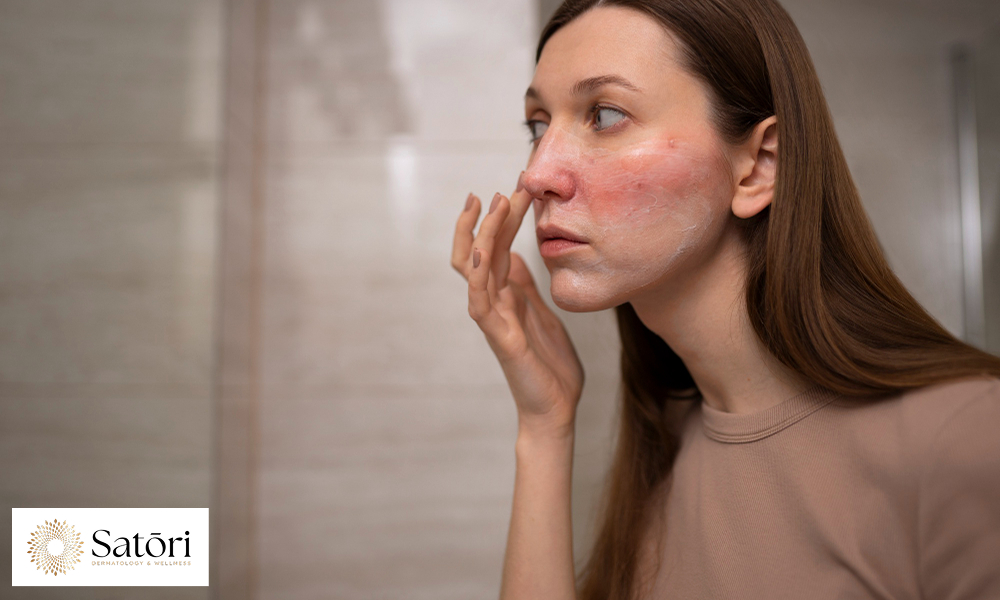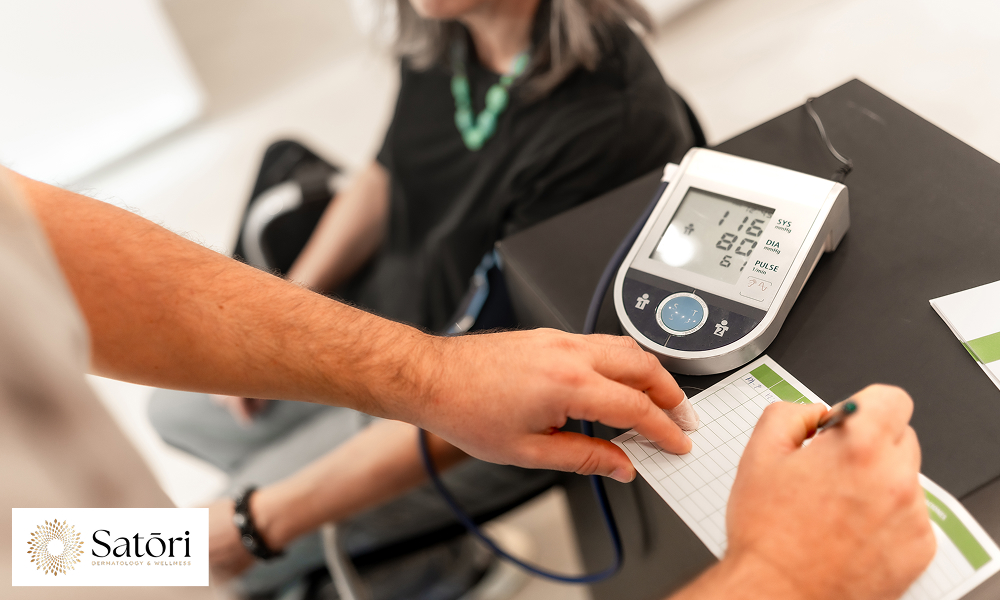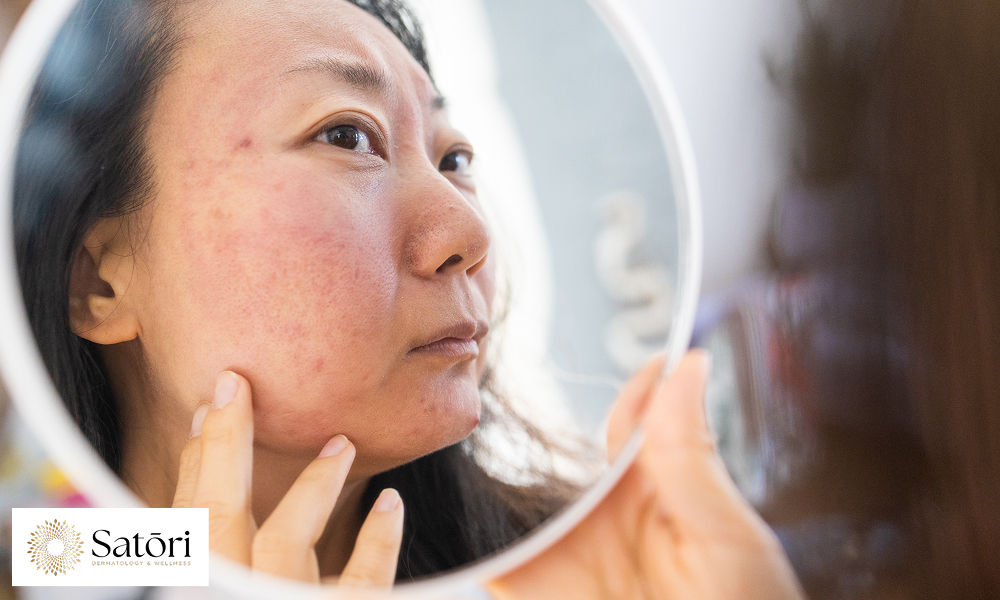You’ve noticed persistent redness across your cheeks that won’t fade. Maybe you’ve tried different skincare products without success. What you might not realize is that the problem could stem from something completely unexpected—your blood pressure.
Recent medical research reveals surprising connections between cardiovascular health and facial rosacea. Doctors are finding that people with rosacea often have elevated blood pressure. It’s not just a coincidence.
This discovery changes how we think about both conditions. Instead of treating facial redness as purely a skin issue, we need to look deeper. Your heart health may be more connected to your complexion than you’d expect.

What Makes Rosacea Different from Normal Facial Redness
Normal blushing comes and goes quickly. Rosacea doesn’t.
This skin condition affects over 16 million Americans, usually starting after age 30. The telltale signs include persistent facial redness, visible blood vessels, and inflammatory bumps that resemble acne. But it’s much more than cosmetic.
Rosacea typically appears in the central face—cheeks, nose, chin, and forehead. The skin often feels hot, burning, or tight. Many people describe a constant sunburned sensation, even indoors.
The condition progresses in stages. It starts with occasional flushing that gradually becomes more frequent and intense. Eventually, temporary redness becomes permanent. Blood vessels become visible through the skin, as some people develop bumps and swelling. For those navigating skincare in your 30s, this is often when rosacea first complicates routines, requiring gentler products and more targeted care.
Common rosacea symptoms include:
- Persistent facial redness
- Visible blood vessels
- Burning or stinging sensations
- Bumps and pimples
- Eye irritation
- Thickened skin (in severe cases)
The unpredictable nature of flare-ups creates real challenges. Social situations become stressful. Simple activities like cooking or exercising can trigger symptoms. Many people avoid certain foods, situations, or environments entirely.
A proper diagnosis of rosacea requires medical evaluation. Dermatologists look for specific patterns of inflammation and rule out other conditions. Early diagnosis matters because rosacea tends to worsen without treatment.

The Reality of High Blood Pressure in Modern Life
High blood pressure affects nearly half of American adults. Most don’t even know they have it.
This condition occurs when blood consistently pushes too hard against artery walls. Over time, this damages blood vessels throughout the body—including the tiny ones in your face.
The impact extends far beyond major arteries. Every blood vessel in your body feels the effects of elevated pressure. The delicate capillaries that nourish facial skin are particularly vulnerable.
Think of it this way: your facial blood vessels are like garden hoses under constant high pressure. Think of it this way: your facial blood vessels are like garden hoses under pressure. Over time, high pressure may make them more reactive and prone to visible changes—something experts believe could contribute to rosacea symptoms in some individuals.
High blood pressure is called the “silent killer” for good reason. It causes significant internal damage while producing few noticeable symptoms. People often discover their hypertension during routine checkups or after complications develop.
The connection to heart disease is well-established. But the effects on smaller vessel networks may contribute to various skin conditions, too. Modern lifestyle factors—stress, poor diet, lack of exercise—fuel both cardiovascular problems and skin issues.
Scientific Evidence Linking Blood Pressure and Rosacea
For years, doctors have noticed something interesting. Some blood pressure medications cause facial flushing as a side effect. Certain vasodilators and calcium channel blockers are notorious for triggering redness and warmth in the face.
This observation got researchers thinking. If medications that affect blood pressure can cause facial flushing, maybe there’s a deeper connection between cardiovascular function and skin symptoms.
But correlation isn’t causation, right? One scientist dug deeper.
According to the National Rosacea Society, Dr. Aditya Gupta from the University of Toronto conducted a study that examined nearly 2,000 dermatology patients, and the results were striking.
Among patients diagnosed with rosacea, 21 percent also had high blood pressure. Compare that to patients without rosacea—only 12 percent had elevated blood pressure. That’s nearly double the rate.
The numbers tell a clear story. When you have rosacea, you’re significantly more likely to have cardiovascular issues, too.
Dr. Gupta’s research revealed something else important. The triggers that rosacea patients reported—sun exposure, stress, alcohol, heat, and exercise—are the exact same factors that can spike blood pressure. This overlap suggests these conditions share common vascular pathways.
The study also uncovered a troubling detail. Most rosacea cases were mild, and only 29 percent of patients even recognized they had the condition. Many people dismiss persistent facial redness as sensitive skin, completely missing the potential cardiovascular connection.
This research raises the possibility that long-term high blood pressure might influence how facial blood vessels behave. Over time, elevated pressure can affect vessel structure and flexibility. This may make the skin more reactive to normal triggers like heat, stress, or alcohol—possibly contributing to frequent flushing episodes in people with rosacea.
Dr. Gupta’s findings remind us that facial redness isn’t always just a cosmetic concern. In some cases, it could be a sign of underlying vascular sensitivity—and might warrant a closer look at overall cardiovascular health.

The Vascular Network Behind Facial Symptoms
Your face contains an intricate network of blood vessels. From large arteries down to microscopic capillaries, this system normally operates with precision.
High blood pressure disrupts this delicate balance. The smallest vessels suffer the most damage because they lack the muscular walls that help larger arteries withstand pressure changes.
Chronic hypertension gradually remodels these tiny vessels. They become thicker, stiffer, and more reactive. What used to be a normal flush becomes an intense, prolonged episode of redness.
The cascade effect is significant. Compromised vessel function leads to increased sensitivity to everyday triggers. A sip of hot coffee might cause intense flushing that lasts for hours.
There’s also an inflammatory component. Damaged vessel walls become more permeable to inflammatory chemicals. This creates a cycle where inflammation worsens vessel dysfunction, which increases inflammation further.
This explains why rosacea patients experience such unpredictable symptoms. Their facial blood vessels are essentially malfunctioning due to underlying vascular damage. Topical treatments alone can’t address this fundamental problem.
The good news? Supporting cardiovascular health may improve how blood vessels function. At the same time, not a direct treatment for rosacea, managing blood pressure can support overall vascular health, which may reduce flare-ups in some patients.
Common Ground Between Heart Health and Skin Health
The overlap between these conditions extends beyond blood vessels. They share multiple risk factors and triggers.
Age is the biggest one. Both high blood pressure and rosacea become more common after 40. Age-related changes in blood vessels contribute to both conditions through similar mechanisms.
Diet plays a huge role, too. Foods that spike blood pressure often trigger rosacea flare-ups:
- Spicy dishes
- Hot beverages
- Alcohol
- High-sodium processed foods
- Caffeine
The inflammatory response these foods trigger affects both your cardiovascular system and your skin simultaneously.
Stress is another major factor. It can cause acute blood pressure spikes and rosacea flare-ups through the same pathways. Chronic stress makes both conditions worse and harder to manage.
Genetics matter too. Family history predicts your risk for both conditions. The inherited factors that affect blood vessel function and inflammatory responses create vulnerability to multiple related problems.
Environmental factors like sun exposure and extreme temperatures impact both conditions. UV radiation damages blood vessels while triggering rosacea symptoms. Temperature extremes stress both your cardiovascular system and your skin.
Even certain medications can affect both conditions. Some blood pressure drugs help rosacea symptoms, while others might worsen them.
Treatment Approaches That Address Both Conditions
Smart management recognizes the connection between these conditions. Treating them together often produces better results than addressing each separately.
Improving blood pressure control frequently reduces rosacea symptom severity. Better cardiovascular health translates to improved blood vessel function throughout your face. Regular monitoring becomes important for tracking both conditions.
When seeking a diagnosis of rosacea, mention any cardiovascular concerns to your doctor. Patients over 40 or those with family histories of heart disease need a comprehensive evaluation. This approach identifies shared risk factors and ensures optimal treatment planning.
Medication coordination requires expertise. Some blood pressure drugs may help reduce facial flushing. Others could potentially worsen rosacea symptoms. Working with healthcare providers who understand both conditions ensures the best outcomes.
The timing matters too. Blood pressure medications often take weeks to reach full effectiveness. During this period, rosacea symptoms may fluctuate in ways that provide valuable information about treatment responses.
Lifestyle modifications offer dual benefits. Single interventions can improve multiple aspects of your health simultaneously. This approach is often more sustainable and effective than managing each condition separately.
Daily Habits That Support Both Heart and Skin Health
Simple lifestyle changes can dramatically improve both conditions. Focus on modifications that provide dual benefits.
Start with your diet. Anti-inflammatory foods support both blood pressure control and rosacea management:
- Fatty fish rich in omega-3s
- Leafy greens and colorful vegetables
- Whole grains
- Nuts and seeds
- Olive oil
Limit processed foods, excess sodium, and known personal triggers. Stay well-hydrated throughout the day.
Exercise helps both conditions, but choose activities carefully. Intense workouts or overheating can trigger facial flushing. Moderate activities work best:
- Brisk walking
- Swimming in cool water
- Gentle cycling
- Yoga or tai chi
Stress management provides powerful dual benefits. Try meditation, deep breathing exercises, or progressive muscle relaxation. These techniques help regulate both blood pressure and rosacea flare-ups.
Sleep quality affects both your cardiovascular system and skin health. Poor sleep disrupts blood pressure regulation while compromising your skin’s ability to repair itself. Aim for 7-9 hours of consistent, quality sleep.
Sun protection is crucial for both conditions. UV radiation increases cardiovascular disease risk while triggering rosacea symptoms. Use broad-spectrum sunscreen daily, wear protective clothing, and seek shade during peak hours.
Temperature control helps too. Avoid extreme heat or cold that can stress both your cardiovascular system and trigger skin symptoms.
Moving Forward with Comprehensive Care
Understanding the connection between high blood pressure and rosacea opens new treatment possibilities. This knowledge empowers better management strategies for both conditions.
Professional evaluation is essential if you’re experiencing persistent facial redness along with cardiovascular risk factors. A comprehensive assessment can identify connections between symptoms while developing personalized treatment plans.
The integrated approach often proves more effective and sustainable. Lifestyle changes that benefit one condition frequently help the other. This creates synergistic effects where single interventions produce multiple health benefits.
Don’t wait to address either condition. Early intervention provides the best opportunity for preventing progression and maintaining quality of life. Whether you focus on cardiovascular health, skin care, or comprehensive lifestyle changes, taking action now creates the foundation for long-term success.
Your face might be telling you something important about your overall health. Listen to what it’s saying.

